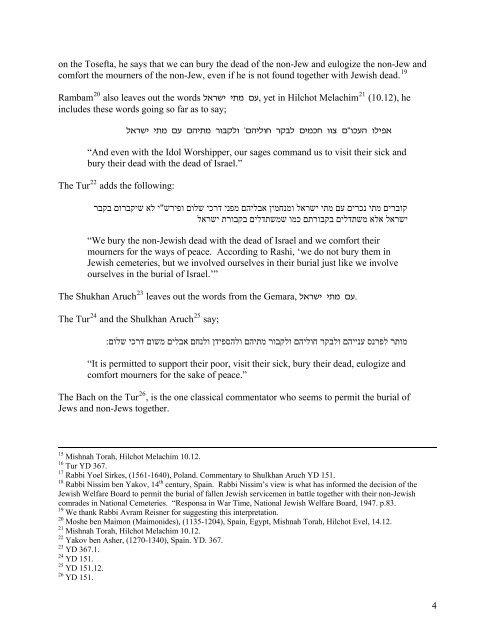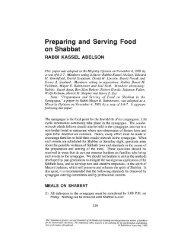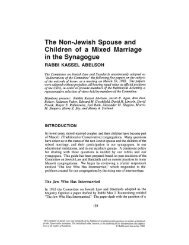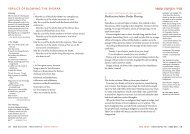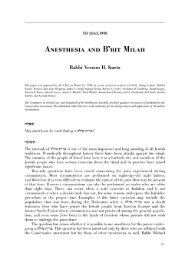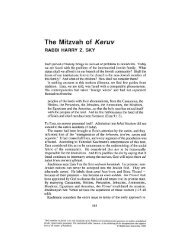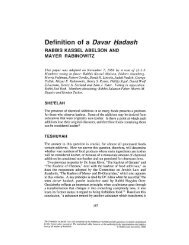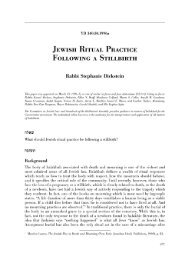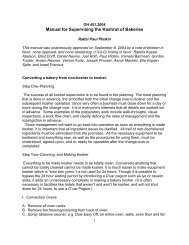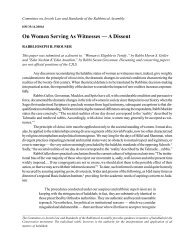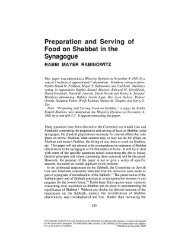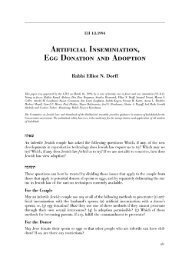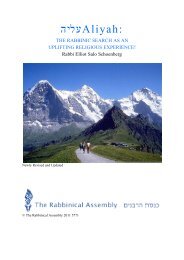Burial of a Non Jewish Spouse and Children - The Rabbinical ...
Burial of a Non Jewish Spouse and Children - The Rabbinical ...
Burial of a Non Jewish Spouse and Children - The Rabbinical ...
Create successful ePaper yourself
Turn your PDF publications into a flip-book with our unique Google optimized e-Paper software.
on the Tosefta, he says that we can bury the dead <strong>of</strong> the non-Jew <strong>and</strong> eulogize the non-Jew <strong>and</strong><br />
comfort the mourners <strong>of</strong> the non-Jew, even if he is not found together with <strong>Jewish</strong> dead. 19<br />
Rambam 20 also leaves out the words ktrah h,n og, yet in Hilchot Melachim 21 (10.12), he<br />
includes these words going so far as to say;<br />
ktrah h,n og ovh,n ruceku wovhkuj reck ohnfj uum o"ufgv ukhpt<br />
“And even with the Idol Worshipper, our sages comm<strong>and</strong> us to visit their sick <strong>and</strong><br />
bury their dead with the dead <strong>of</strong> Israel.”<br />
<strong>The</strong> Tur 22 adds the following:<br />
קוברים מתי נכרים עם מתי ישראל ומנחמין אבליהם מפני דרכי שלום ופירש"י לא שיקברום בקבר<br />
ישראל אלא משתדלים בקבורתם כמו שמשתדלים בקבורת ישראל<br />
“We bury the non-<strong>Jewish</strong> dead with the dead <strong>of</strong> Israel <strong>and</strong> we comfort their<br />
mourners for the ways <strong>of</strong> peace. According to Rashi, ‘we do not bury them in<br />
<strong>Jewish</strong> cemeteries, but we involved ourselves in their burial just like we involve<br />
ourselves in the burial <strong>of</strong> Israel.’”<br />
<strong>The</strong> Shukhan Aruch 23 leaves out the words from the Gemara, ktrah h,n og.<br />
<strong>The</strong> Tur 24 <strong>and</strong> the Shulkhan Aruch 25 say;<br />
מותר לפרנס ענייהם ולבקר חוליהם ולקבור מתיהם ולהספידן ולנחם אבלים משום דרכי שלום:<br />
“It is permitted to support their poor, visit their sick, bury their dead, eulogize <strong>and</strong><br />
comfort mourners for the sake <strong>of</strong> peace.”<br />
<strong>The</strong> Bach on the Tur 26 , is the one classical commentator who seems to permit the burial <strong>of</strong><br />
Jews <strong>and</strong> non-Jews together.<br />
15 Mishnah Torah, Hilchot Melachim 10.12.<br />
16 Tur YD 367.<br />
17 Rabbi Yoel Sirkes, (1561-1640), Pol<strong>and</strong>. Commentary to Shulkhan Aruch YD 151.<br />
18 Rabbi Nissim ben Yakov, 14 th century, Spain. Rabbi Nissim’s view is what has informed the decision <strong>of</strong> the<br />
<strong>Jewish</strong> Welfare Board to permit the burial <strong>of</strong> fallen <strong>Jewish</strong> servicemen in battle together with their non-<strong>Jewish</strong><br />
comrades in National Cemeteries. “Responsa in War Time, National <strong>Jewish</strong> Welfare Board, 1947. p.83.<br />
19 We thank Rabbi Avram Reisner for suggesting this interpretation.<br />
20 Moshe ben Maimon (Maimonides), (1135-1204), Spain, Egypt, Mishnah Torah, Hilchot Evel, 14.12.<br />
21 Mishnah Torah, Hilchot Melachim 10.12.<br />
22 Yakov ben Asher, (1270-1340), Spain. YD. 367.<br />
23 YD 367.1.<br />
24 YD 151.<br />
25 YD 151.12.<br />
26 YD 151.<br />
4


